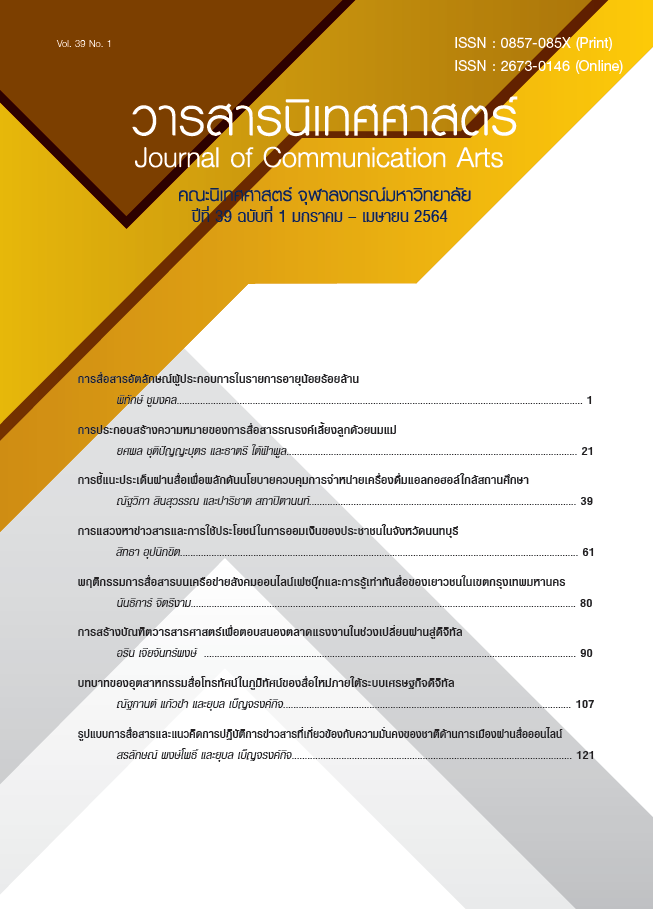Creating Journalism Graduates to Serve the Labor Market in the Age of Digital Transformation
Main Article Content
Abstract
The purpose of this research article is to study the labor market’s requirement for journalistic qualification in the age of digital transformation. The research adopts a discussion group and in-depth interview on the digital journalism topic in conducting the study which took place between 12 February – 1 March 2020. The participants of the discussion group are alumni of School of Journalism who are currently professional journalists in print, broadcast, and online media. The in-depth interviewees are editors who are employers of graduates, and experts in journalism who are executives of media organizations.
The study found that the labor market needs journalists with three characteristics: 1) competency to produce in-depth content, 2) diversity in presentation, and 3) quality production and publication. The first characteristic of competency to produce in-depth content means the journalist can quickly capture the key points, critically analyze the issue, thoroughly understand the issue, provide different aspects of the issue, and systematically carry out the research, information -collection and explanation the issue. This qualification derives from knowledge and skills in journalism and interdisciplinarity. The second characteristic of diversity in presentation refers to the ability to write a story that is easy for audience to digest and, understand, while using different types of technology and media in telling and reporting issues to serve consumers’ needs. The last characteristic of quality production and publication means the graduates can quickly adjust themselves to and deliver works or writing pieces to be on par with professional standards in a limited time, along with obtaining business and marketing knowledge.
Lastly, these three features must come with a set of preferable attitude: patience, openness, readiness to learn, and flexibility. These qualities can be cultivated by the designing of curriculum that encourages students to be eager to seek knowledge and to learn by themselves. For instance, the curriculum should provide arduous training, support of contest participation, and knowledge-sharing from guest speakers. Finally, the thesis should reflect the student’s thinking process and the application of student’s knowledge and skills.
Article Details
References
กฤษฏา ศุภวรรธนะกุล. (2555). คนทำสื่อใหม่ถก 'วารสารศาสตร์ตายแล้ว' นักวิชาการชี้หนังสือพิมพ์วูบ-ต้องปรับตัวสู้ สื่อพลเมืองโต-โซเชียลมีเดียชี้นำข่าวสาร. วันที่เข้าถึงข้อมูล 21 เมษายน 2563, แหล่งที่มา https://www.tcijthai.com/news/2012/19/scoop/750
กาญจนา แก้วเทพ. (2555). คู่มือสื่อใหม่ศึกษา. กรุงเทพฯ: ภาพพิมพ์.
จารุกิตติ์ ธีรตาพงศ์. ผู้สื่อข่าว สำนักข่าวไทยพับลิก้าออนไลน์. (16 กุมภาพันธ์ 2563) สัมภาษณ์.
จิรเดช โอภาสพันธ์วงศ์. บรรณาธิการ นิตยสารอะเดย์. (23 กุมภาพันธ์ 2563) สัมภาษณ์.
ชญานิศ จำปีรัตน์. ผู้จัดการด้านเนื้อหา เพจฟิวเจอร์ เทรนด์ ภายใต้บริษัทไลค์ มี. (16 กุมภาพันธ์ 2563) สัมภาษณ์.
ไชยรัตน์ เจริญสินโอฬาร. (2561). วาทกรรมกับอำนาจ. ใน อำนาจไร้พรมแดน ภาษา วาทกรรม ชีวิตประจำวันและโลกที่เปลี่ยนแปลง. กรุงเทพฯ: วิภาษา, 71-137.
ณัชชา เชี่ยวกล. นักออกแบบกราฟิก ฝ่ายประชาสัมพันธ์และการตลาด สำนักพิมพ์มติชน. (16 กุมภาพันธ์ 2563) สัมภาษณ์.
ณัชปกร นามเมือง. (2563). 10 ปี พฤษภา 2553: การเดินทางของความจริงและความยุติธรรม. วันที่เข้าถึงข้อมูล 14 สิงหาคม 2563, แหล่งที่มา https://themomentum.co/justice-10-years-red-shirt-crackdown/
นภพัฒน์จักษ์ อัตตนนท์. บรรณาธิการข่าว เวิร์คพ้อยท์ ออนไลน์. (23 กุมภาพันธ์ 2563) สัมภาษณ์.
ปกป้อง จันวิทย์. (2563). Editor’s Note 2020: ทางรอดของสื่อยุคดิจิทัล “สื่อต้องเป็นสื่อ และกลับคืนสู่มือประชาชน”. วันที่เข้าถึงข้อมูล 28 ตุลาคม 2563, แหล่งที่มา https://www.the101.world/editors-note-2020/
ปณชัย อารีเพิ่มพร. ผู้สร้างสรรค์เนื้อหา เว็บไซต์เดอะสแตนดาร์ด. (16 กุมภาพันธ์ 2563) สัมภาษณ์.
ปาณิส โพธิ์ศรีวังชัย. คอลัมนิสต์และบรรณาธิการสารคดีและบทความ เว็บไซต์ดิวันโอวันดอทเวิลด์. (16 กุมภาพันธ์ 2563) สัมภาษณ์.
ผู้จัดการรายวัน 360 องศา. (2562, 3 ตุลาคม). กสทช.สรุป 5 ปี "ทีวีดิจิทัล" ปิดฉาก 9 ช่อง "เลิกจ้าง" กระทบคนสื่อ-ครอบครัวเกือบ 15,000 คน, 12.
แรนดัล, เดวิด. (2559). คนข่าวฉลาดทำงานศตวรรษ 21 [The Universal Journalist] (สุนันทา แย้มทัพ, ผู้แปล). กรุงเทพฯ: มูลนิธิเพื่อการศึกษาประชาธิปไตยและการพัฒนา (โครงการจัดพิมพ์คบไฟ).
วุฒิพงษ์ วงษ์ชัยวัฒนกุล. เจ้าหน้าที่ยุทธศาสตร์และพัฒนาเนื้อหาข้ามสื่อ สถานีโทรทัศน์ไทยพีบีเอส. (16 กุมภาพันธ์ 2563) สัมภาษณ์.
ศุภาวรรณ คงสุวรรณ์ และภาวรรณ ธนาเลิศสมบูรณ์. (2563). วารสารศาสตร์ต้องรอด. วันที่เข้าถึงข้อมูล 28 เมษายน 2563, แหล่งที่มา https://www.the101.world/journalism-must-survive/
ศูนย์ข้อมูล & ข่าวสืบสวนเพื่อสิทธิพลเมือง (TCIJ). (2559). Ideology & Re-define สื่อทางเลือก. ใน ถอดรื้อมายาคติ เล่ม 2. เชียงใหม่: หจก.วนิดาการพิมพ์, 237-257.
ศูนย์ข้อมูลและข่าวสืบสวนเพื่อสิทธิพลเมือง. (2562). Media Disruption: EP1 ไทม์ไลน์และพฤติกรรมผู้เสพสื่อที่เปลี่ยนไปในระดับโลก. วันที่เข้าถึงข้อมูล 24 เมษายน 2563, แหล่งที่มาhttps://www.tcijthai.com/news/2019/8/
scoop/9281
______________________________. (2562). Media Disruption: EP8 ผลกระทบต่อ 'สิทธิแรงงาน' คนทำงานสื่อ. วันที่เข้าถึงข้อมูล 24 เมษายน 2563, แหล่งที่มา https://www.tcijthai.com/news/2019/18/scoop/9586
สมาคมโฆษณาแห่งประเทศไทย. (2563). ข้อมูลการใช้งบโฆษณาในเมืองไทย. วันที่เข้าถึงข้อมูล 24 เมษายน 2563, แหล่งที่มา http://www.adassothai.com/index.php/main/ad_expenditure
สมาคมนักข่าวนักหนังสือพิมพ์แห่งประเทศไทย. (2562). #นิเทศศาสตร์ Never Die รายงานประจำปี 2562. กรุงเทพฯ: สมาคมนักข่าวนักหนังสือพิมพ์แห่งประเทศไทย.
อธิชา สุขจิตสำราญ. อดีตผู้สื่อข่าว สถานีโทรทัศน์พีพีทีวี. (16 กุมภาพันธ์ 2563) สัมภาษณ์.
อนันต์ ลือประดิษฐ์. ผู้อำนวยการและบรรณาธิการบริหาร เดอะพีเพิล. (1 มีนาคม 2563) สัมภาษณ์.
อินทร์แก้ว โอภานุเคราะห์กุล. ผู้สื่อข่าว เวิร์คพ้อยท์ ออนไลน์. (16 กุมภาพันธ์ 2563) สัมภาษณ์.
อุบลรัตน์ ศิริยุวศักดิ์. (2544). พื้นที่สาธารณะใหม่ของประชาชน. ใน ข่าวที่ไม่เป็นข่าว. กรุงเทพฯ: โรงพิมพ์เดือนตุลา, 10-17.
ไอโกะ ฮามาซากิ. (2562). สำรวจชั้นหนังสือ เมื่อ 'นิตยสาร-นสพ.' ทยอยปิดตัว 'หนังสือเล่ม' จะรอดไหม?. วันที่เข้าถึงข้อมูล 24 เมษายน 2563, แหล่งที่มา https://www.tcijthai.com/news/2019/4/scoop/9005
Borchardt, Alexandra. (2018). How to be an excellent leader in news [infographic]. Retrieved April 23, 2020, from https://reutersinstitute.politics.ox.ac.uk/risj-review/how-be-excellent-leader-news
Bradshaw, Paul. (2011). The Online Journalism Handbook: Skills to survive and thrive in the digital age. England: Ashford Colour Press Ltd.
Clark, R.P. (2014). The Pyramid of Journalism Competence: what journalists need to know. Retrieved April 21, 2020, from https://www.poynter.org/reporting-editing/2014/the-pyramid-of-journalism-competence-what-journalists-need-to-know/?fbclid=IwAR13A0qfCzK3YQPSrnl_RpauT0PL2TTOaE9XccjsEQydcAo67c1Ozii3iqY
Dominick, J.R. (2011). The Dynamics of Mass Communication: Media in Transition. 11th Edition. New York: McGraw-Hill, Chapter 12.
Kovach, Bill and Rosenstiel, Tom. (2007). The Elements of Journalism. New York: Three Rivers Press.
Marshall, Sarah. (2013). BBC News website editor: Five key digital journalism skills. Retrieved April 23, 2020, from https://www.journalism.co.uk/news/five-must-have-skills-if-you-want-to-work-for-the-bbc-news-website/s2/a551681/
University of Wisconsin–Madison. (2020). REPORTING. Retrieved April 23, 2020, from: https://journalism.wisc.edu/undergraduate/reporting/


